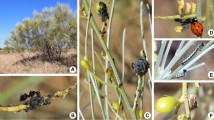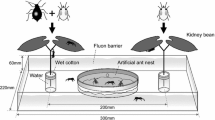The influence of foraging by the ant, Lasius niger, on the population growth of two aphid species, Lachnus tropicalis and Myzocallis kuricola, on chestnut trees, Castanea crenata, was examined. The ant-tending effect was divergent depending on the aphid density per ant: it was positive when there were few aphids per ant, but negative when there were many aphids per ant. In addition, the density of one aphid species also influenced the ant-tending effect on the other aphid. Furthermore, the influences were asymmetrical: an increase in L. tropicalis density per ant reversed the ant’s effect on this species and on M. kuricola, while an increase in M. kuricola per ant did not significantly influence the ant’s effect on L. tropicalis. Thus, the ant seems to stabilize the L. tropicalis population density and keep this species from extinction, while the ant’s effect on M. kuricola depends on the density of L. tropicalis and may lead M. kuricola to extermination. This change in the ant-tending effect corresponds to the previously detected density-dependent change in predation activity of the ants on aphids. In contrast, the density-dependent change in the protection effect of the ants against natural enemies does not explain the results.
Similar content being viewed by others
REFERENCES
Addicott J. F. (1979) A multispecies aphid–ant association: Density dependence and species-specific effects. Canadian Journal of Zoology 57: 558–569.
Banks C. J. (1962) Effects of the ant Lasius niger (L.) on insects preying on small populations of Aphis fabae Scop. on bean plants. Annals of Applied Biology 50: 669–679.
Banks C. J. & Macauley E. D. M. (1967) Effects of Aphis fabae Scop. & of its attendant ants and insect predators on yields of field beans (Vicea faba L.). Annals of Applied Biology 60: 445–453.
Boucher D. H. (1985). The Biology of Mutualism. Oxford University Press, New York.
Breton L. M. & Addicott J. F. (1992) Density-dependent mutualism in an aphid–ant interaction. Ecology 73: 2175–2180.
Bristow C. M. (1991) Why are so few aphids ant-tended. In: Ant–Plant Interactions (eds C. R. Huxley & D. F. Cutler) pp. 104–119. Oxford University Press, New York.
Buckley R. C. (1987) Interactions involving plants, Homoptera, and ants. Annual Review of Ecology and Systematics 18: 111–135.
Cherix D. (1987) Relation between diet and polyethism in Formica colonies. In: From Individual to Collective Behavior in Social Insects (eds J. M. Pasteels & J. D. Deneubourg) pp. 93–115. Brikhauser, Basel, Belgium.
Cushman J. H. & Addicott J. F. (1989) Intra-specific and interspecific competition for mutualists: Ants as a limited and limiting resource for aphids. Oecologia 79: 315–321.
Cushman J. H. & Whitham T. G. (1989) Conditional mutualism in a membracid–ant association: Temporal, age-specific, and density-dependent effects. Ecology 70: 1040–1047.
Itioka T. & Inoue T. (1996) Density-dependent ant attendance and its effects on the parasitism of a honeydew-producing scale insect, Ceroplastes rubens. Oecologia 106: 448–454.
Menge B. A. (1995) Indirect effects in marine rocky intertidal interaction webs: Patterns and importance. Ecological Monographs 65: 21–74.
Pontin A. J. (1958) Preliminary note on the eating of aphids by ants of the genus Lasius. Entomologist’s Monthly Magazine 94: 9–11.
Pontin A. J. (1978) The numbers and distribution of subterranean aphids and their exploitation by the ant Lasius flavus Fabr. Ecological Entomology 3: 203–207.
Rosengren R. & Sundström L. (1991) The interaction between red wood ants, Cinara aphids, and pines. A ghost of mutualism past? In: Ant– Plant Interactions (eds C. R. Huxley & D. F. Cutler) pp. 80–91, Oxford University Press, New York.
Sakata H. (1994) How an ant decides to prey on or to attend aphids. Researches on Population Ecology 36: 45–51.
Sakata H. (1995) Density-dependent predation of the ant Lasius niger (Hymenoptera: Formicidae) on two attended aphids Lachnus tropicalis and Myzocallis kuricola (Homoptera: aphididae). Researches on Population Ecology 37: 159–164.
SAS Institute Inc. (1990) SAS/STAT User’s Guide, Version 6. SAS Institute Inc., Cary, NC.
SAS Institute Inc. (1996) SAS/STAT Software Changes and Enhancements. SAS Institute Inc., Cary, NC.
Searle S. R., Speed F. M., Milliken G. A. (1980) Population marginal means in the linear model: an alternative to least squares means. American Statistician 34: 216–221.
Skinner G. J. & Whittaker J. B. (1981) An experimental investigation of interrelationships between the wood ant (Formica rufa) and some tree-canopy herbivores. Journal of Animal Ecology 50: 313–326.
Stadler B. & Dixon A. F. G. (1998) Cost of ant attendance for aphids. Journal of Animal Ecology 67: 454–459.
Way M. J. (1954) Studies on the association of the ant Oecophylla longinoda with the scale insect Saissetia zanzibarensis. Bulletin of Entomological Research 45: 113–134.
Way M. J. (1963) Mutualism between ants and honeydew-producing Homoptera. Annual Review of Entmology 8: 307–344.
Wootton J. T. (1994) The nature and consequences of indirect effects in ecological communities. Annual Review of Ecology and Systematics 25: 443–466.
Author information
Authors and Affiliations
Corresponding author
About this article
Cite this article
Sakata, H. Indirect interactions between two aphid species in relation to ant attendance. Ecol Res 14, 329–340 (1999). https://doi.org/10.1046/j.1440-1703.1999.00312.x
Received:
Accepted:
Issue Date:
DOI: https://doi.org/10.1046/j.1440-1703.1999.00312.x




